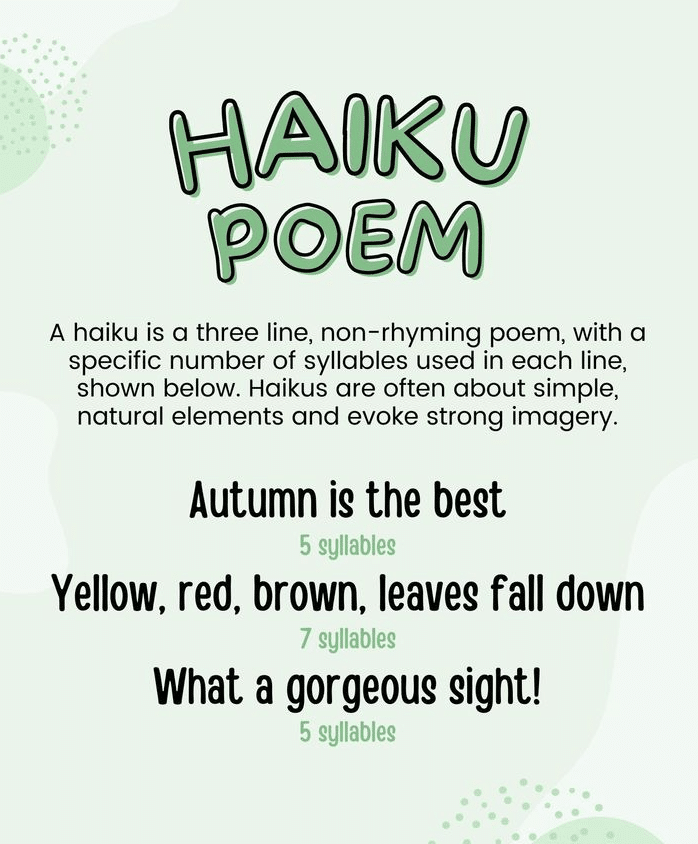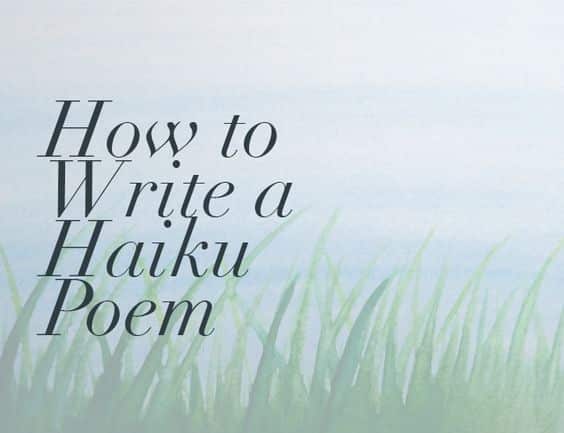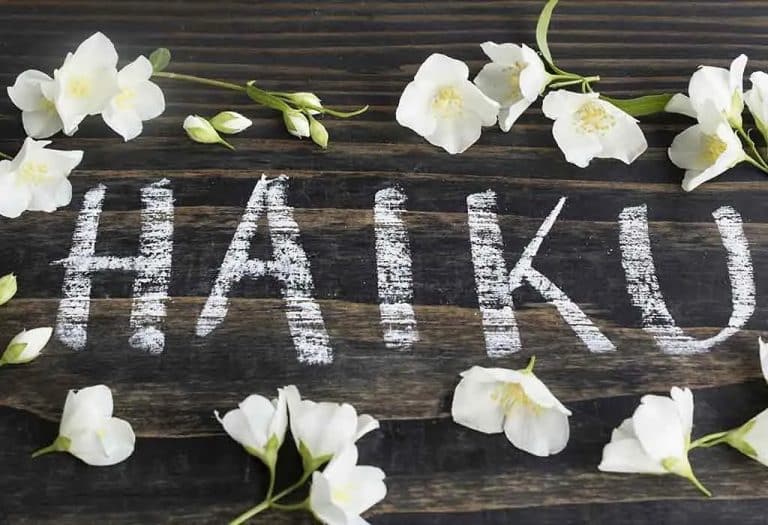Have you ever heard of Haiku? Haiku, a classic style of Japanese poetry, with its simplicity and evocative quality, has captivated people’s minds and emotions for centuries. The simplicity of Haiku, which only has three lines and a 5-7-5 syllable pattern, makes it an art form.
Haiku authors expertly condense nature, feelings, and fleeting moments into these seventeen syllables, inspiring readers to take a moment to appreciate the beauty of their surroundings.
Haiku allows middle school kids to explore the depth of language, tap into their creativity, and better understand the world. Young poets can express their feelings and thoughts in Haiku with clarity and elegance, making it a fun and educational activity.
Haiku gives young poets the confidence to find their voices and enjoy poetry in ordinary moments, whether they write about the changing seasons, the beauties of nature, or the simple pleasures of life.
List of Haiku Examples 5-7-5 for Middle School Kids
Let the poetry journey begin with a list of 45 haiku examples 5-7-5, as middle school children learn the craft of the haiku and start a lifetime of respect for the wonders of language and the environment.
Nature’s Symphony: Haiku Examples 5-7-5
1. Peaceful moonlight glows,
Whispers dance among trees,
Night’s lullaby sings.
2. Petals falling slowly,
Springs Confetti on the breeze,
Nature’s grand procession.
3. Chirping Birds taking flight,
Painting the sky with melodies,
A symphony rises.
4. The tides dance eternally,
The water murmurs the serenity,
Waves caress the coast.
Stillness in The Moment: Haiku Examples 5-7-5
5. Raindrops weep softly,
Bringing calm in the storm,
Earth’s tears purify the soul.
6. Sun slants to the west,
Shadow embraces the waning light,
Day’s curtain is drawn.
7. Moonlight gently caresses,
Night’s embrace cradles the stars,
Dreams soar above.
The Season’s Dance: Haiku Examples 5-7-5
8. Winter breath descends,
Frosty lace draped the world,
Earth slumbers in snow.
9. Soft rains fall,
Spring sweet touch upon the earth,
Life awakens and blossoms.
10. The golden kiss of summer,
Sunlight dances on the skin,
Happy days unfold.
11. Leaves of gold and red,
Autumn’s tapestry unveiled,
Nature’s magnificent encore.
Feelings Unveiled: Haiku Examples 5-7-5
12. Heart dances with joy,
Love’s Symphony in Motion,
Soul harmony is attained.
13. Tears of sorrow flow,
Heart swallowed by grief’s ocean,
Healing whispers rise.
14. Dreams fly like kites,
Hope’s tendrils touch the heaven,
Tomorrow’s promise is made.
Life’s Wonder: Haiku Examples 5-7-5
15. Laughter fills the atmosphere,
Hearts of friends are united,
Childhood memories.
16. Pages come to life,
Words weave some fantastic tales,
Imagination soars.
17. Candle Flickers,
Times journey traced in flame,
A moment’s presence.
Whispers of Nature: Haiku Examples 5-7-5
18. Butterfly’s flight,
Nature’s canvas moving,
Breath of beauty revealed.
19. Lone wolf’s haunting cry,
Moonlight melody develops,
Wildness in the night.
20. The hummingbird’s ballet,
Jeweled acrobat of nature,
Grace in the air.
The Magic of Season: Haiku Examples 5-7-5
21. Snowflakes dance and twirl,
Winter’s wonderland takes new shape,
Nature’s artistry talent.
22. Blossoms are blooming,
Spring’s confetti on the breeze,
Entrance of nature.
23. A warm hug from the sun,
Summer’s fire lights the sky,
Vibrant hues of life.
24. Leaves paint the landscape,
Autumn tapestry unveiled,
Nature’s final bow.
The Celestial Serenity: Haiku Examples 5-7-5
25. Milky Way embrace,
Constellation dance in the night,
Nature’s cosmic performance.
26. Ballet of Aurora,
Shades of the polar skies,
Nature waltz of light.
27. Comet Streaks on high,
Celestial Journey path,
Nature’s shooting star.
The Forest Mysteries: Haiku Examples 5-7-5
28. Whispers in the breeze,
Secrets of Nature in the Woods,
Unwritten historical stories.
29. Sunlight filters through,
Nature’s Cathedral of Trees,
Sacred woodland Hymn.
Creatures of Wonder: Haiku Examples 5-7-5
30. Fireflies Glowing,
Charming Lanterns in the sky,
Nature’s fairy lights.
31. Elephant’s grand march,
Nature gentle giant roams,
Walks of Wisdom.
32. Coyote’s moon howl,
Mysterious serenade of night,
Nature’s wild spirit.
Whispers of Rain: Haiku Examples 5-7-5
33. Raindrops on the roof,
Rhythmic song of nature,
Softly calms the soul.
34. Pitter Patter Sound,
Raindrops on the window,
Nature’s gentle touch.
35. Rainbow after the rain,
Nature’s Promise in the Sky,
Hope’s embracing hug.
The Seaside Dreams: Haiku Examples 5-7-5
36. Seashells on the shore,
Nature’s treasure from the deep,
Echoes of the sea.
37. Seagull’s beautiful glide,
Oceans Messenger on the flight,
Nature’s winged delight.
38. Lighthouse beacon’s guide,
Nature’s sentinel of ships,
Guiding home safely.
The Glowing Glow: Haiku Examples 5-7-5
39. Golden hour’s glow,
Sun’s blazing departure,
Nature’s warm embrace.
40. Pastel sky of Eve,
Evening serene masterpiece,
Nature’s soothing balm.
41. Emerging silhouettes,
Twilight dances with fading light,
Nature’s grand finale.
The Mountain Majesty: Haiku Examples 5-7-5
42. Majestic eagle soars in the sky,
Mountain’s guardian in flight,
Nature’s sovereign grace.
43. Thunder echoes loudly,
Mountains rumbling voice resounds,
Ferocious strength of nature.
Colors of The Garden: Haiku Examples 5-7-5
44. Iris blooms in spring,
Nature’s vibrant painted brush,
Kaleidoscope Shades.
45. Lavender in bloom,
Garden’s fragrant purple haze,
Nature’s calming scent.
With these haiku examples, young minds discover the power of simplicity and learn to appreciate the beauty of ordinary occurrences as they delve deeper into haiku. Each haiku serves as a vehicle for personal expression, developing a closer bond with the natural world and feelings.
What is the Significance of Haiku?
Haiku’s distinctive and timeless traits give it a special place in poetry and literature. With its three-line structure and 5-7-5 syllable pattern, this classical Japanese literary form has attracted people worldwide and cut over cultural barriers.
Here are some reasons explaining the significance of Haiku’s profound effect on poets and readers.
1. Essence of Simplicity
The main characteristic of Haiku is its simplicity. Haiku poets express complex feelings, vivid imagery, and intricate experiences in just seventeen words. Because of the limited word count, writers must choose their word limit carefully, giving each weight and impact. Haiku communicates the core of feelings and experiences in a potent and memorable way by condensing complex ideas into a brief structure.
2. Invitation to Stop and Reflect
Haiku enables readers to take a moment to pause and consider the beauty and intricacies of life. Each Haiku offers a glimpse into a particular moment, provoking readers to reflect on the setting or feeling conveyed. Haiku serves as a gentle reminder to slow down, enjoy the moment, and be grateful for the beauties of the world around us in our fast-paced world.
3. Celebration of Nature
Haiku place a strong emphasis on nature. Haiku encourages a strong connection with the environment through evocative depictions of the seasons, landscapes, and natural phenomena. This appreciation of nature is consistent with traditional Japanese aesthetics, which strongly emphasize the coexistence of people and the natural world.
4. Evocation of Emotions
Despite its concision, Haiku has a unique capacity to provoke intense emotions. Haiku writers can evoke various emotions, from happiness and peace to melancholy and longing, by carefully selecting words and sensory images. The sentiment of the Haiku frequently moves readers on an emotional level and makes them feel connected to it.
5. Promotion of Mindfulness
Writing and Reading haiku both foster mindfulness. Poets embrace the present moment and draw inspiration from their immediate surroundings and experiences. The reflective aspects of Haiku draw readers in, and as a result, they become more aware of the little things in life.
6. Universality and Cross-Cultural Appeal
Haikus’ structure and subjects are universal, making them understandable and appealing to people from all backgrounds and cultures. Haiku is a type of poetry that began in Japan but has now spread worldwide. Through everyday human experiences and enduring emotions, it acts as a bridge to unite individuals.
7. Improvement of Words Skills
Writing Haiku requires poets to use words more precisely and sparingly. The limited number of syllables necessitates a careful evaluation of the impact and meaning of each term. Poets hone their language abilities. As a result, they are improving their capacity to succinctly and powerfully communicate complicated concepts.
8. Development of Observational Skills
Haiku fosters a strong eye for detail. Poets become more perceptive of the intricacies in their environment as they look to nature and commonplace events for inspiration. It raises awareness and improves their capacity to appreciate beauty in everyday situations.
9. Exploration of Haikus Legacy
Haiku gives writers the chance to delve into a rich poetic legacy. They are introduced to renowned poets from the past, such as Matsuo Bash, Kobayashi Issa, and Yosa Buson, by learning about the development of the haiku form. Poets gain inspiration and an understanding of the fundamentals of Haiku through their works.
10. Creative Outlet
Haiku can be used as a creative outlet for self-expression and emotional release. It enables poets to succinctly and profoundly express their deepest thoughts and feelings. Because of how successfully writers may communicate their emotions in Haiku’s spare form, this genre of writing is both therapeutic and gratifying.
The significance of haiku resta is its capacity to express the beauty and complexity of life in a few simple lines. Poets learn the value of brevity and the effect of vivid imagery as they take on the challenge of creating meaningful statements within the boundaries of its structure.
Process of Haiku Making
A haiku is a poetic form that values conciseness and powerful imagery. Developing keen observational abilities, choosing exact words, and capturing brief moments with depth and emotion are all necessary steps. Here is a step-by-step guide on how to write a Haiku.
1. Always Look for Inspiration
To start, look for Inspiration in your surroundings, nature, feelings, or daily experiences. Haiku frequently draws Inspiration from beauty, Simplicity, and interhuman connection. Adopt mindfulness and pay attention to life’s small, often overlooked details.
2. Decide on a Theme
Choose a topic or theme for your haiku. It might be a particular nature scene, an emotion, or an everyday observation. To effectively communicate the substance of your poem, concentrate on a specific instance or image.
3. Use the Conventional 5-7-5 Syllable Pattern
When counting the number of syllables. Three lines should each have five, seven, and five syllables, starting with the first line. Although the syllable structure is flexible, it is the traditional haiku structure.
4. Accept Seasonal References
Consider seasonal references or kigo to link your haiku to nature and the passage of time. Your poem gains depth and cultural complexity thanks to these words or images that invoke the particular season or time of the year.
5. Paint Pictures in The Reader’s Imagination
Use descriptive language to conjure up pictures in the reader’s imagination. Put a focus on the senses of sight, sound, touch, taste, and smell. We are enhancing the impact of youth haiku by appealing to the reader’s mind.
6. Emphasize Simplicity
Adopt a theme and language that are straightforward. Haiku thrives on concision and Simplicity. Give readers the freedom to interpret and interact with the poem by using clear, succinct language to deliver your meaning.
7. Add a Cutting Word
In a traditional Japanese haiku, a kireji or cutting word is sometimes added at the end of the first or second life. The kireji serves as a pause or juxtaposition, lending the poetry a sense of profundity and introspection.
8. Add Line Breaks
Haiku contains intentional and meaningful line breaks. Each phrase should effortlessly flow while still evoking awe and discovery. Try out several line breaks to get the rhythm and impact you want.
9. Read Aloud and Revise
After writing your haiku, read it out loud to judge its effect and the rhythm and flow of the poem. Pay attention to the number of syllables, the accuracy of the imaginary, and the emotional impact. Make any revisions and refinements to your haiku to make a more polished and effective poem.
10. Consider Emotions
Think about the feelings your haiku arouses. A transient moment that evokes strong emotions in the reader is frequently captured in a haiku. Consider how your makes you feel and whether it successfully captures the feelings you were trying to portray.
11. Share Your Haiku and Invite Criticism
Share your haiku with others and invite constructive criticism. You can obtain new insights and hone your craft by sharing your work. Take advantage of the chance to learn from other authors and haiku fans.
12. Accept Patience and Practice
Haiku writing is a skill that improves with time and practice. Accept the process of creating haiku and realize that each effort advances your development as a poet. Give yourself room to try new things, learn new skills, and improve over time.
Writing a haiku is a literary journey that honors emotional resonance, observation, and Simplicity. You set out on a journey that leads to the essence of haiku by immersing yourself in the beauty of fleeting moments and improving your language abilities. Accept the craft of haiku writing and let the profound impact of Simplicity permeate your poetry.
Things to Keep in Mind While Creating Haiku
Haiku writing, the exquisite art of simplicity and imagination, calls for careful consideration to successfully provoke feelings and portray fleeting moments.
Take into account the following advice as you begin composing haiku to increase the impact and beauty of your poems:
1. Always Use the 5-7-5 Rule
Your poem will have a straightforward and pleasing flow if you follow the standard haiku structure of 5-7-5 syllables throughout three lines. Your haiku will preserve its purity and gain rhythm by being adept at this technique.
2. Concentrate on Single Moment
The haiku form is characterized by capturing a single observation or moment. Avoid cluttering your poetry with concepts by letting it focus on one specific scenario or emotion.
3. Use Vivid Imagery
Use your words to create vivid mental pictures that pique the reader’s interest. Give your haiku some life using descriptive language to transport the reader to the scene.
4. Use Kigo
Include kigo or seasonal references to give your haiku a culturally rich feel. These conjure up particular times of the year or natural moments, inviting readers to connect profoundly with the poem’s core ideas.
5. Stress the Now Moment
Haiku thrives on the now; therefore, use the present tense to convey urgency and attention. Let your poetry capture the present and encourage readers to savor the feeling moments.
6. Use Cutting Word
Think about adding a cutting word placed purposely in your haiku to generate pauses and juxtapositions. It deepens the poetry and encourages reflection, which draws readers into the poem’s core.
7. Embrace White Space
White space is just as crucial to haikus’ visual art as the syllables. By skillfully utilizing white space, which heightens the poem’s visual impact and encourages reflection, you can give your poem room to breathe.
8. Use Clear and Straightforward Language
Haikus’ core is simplicity. Avoid using overly complex language and instead choose straightforward, short words. Each word should convey as much meaning and images as possible.
9. Emotionally Engage
Haiku’s brevity can arouse feelings. To write poetry that has a strong emotional impact on readers, draw on either universal feelings or personal experiences.
10. Read Your Haiku Out Loud
After writing your haiku, read it out loud to check for flow, rhythm, and emotional resonance. Revise as necessary to enhance the poem’s effect and ensure its expression is clear.
11. Pay Attention to Line Breaks
Haikus’ musicality depends on its line breaks. Try out several configurations to find the right rhythm while keeping the element of surprise.
12. Celebrate the Beauty of Simplicity
Above all, cherish the beauty inherent in life’s most straightforward experiences. Accept deliberate observation and introspection, amplifying the haiku’s lyrical core with the power of beauty.
13. Find Balance in Nature
Haiku frequently focuses on the natural world. Strive to achieve harmony between the natural environment and human experience. To foster a deeper understanding of how intertwined all of life is, create a harmonic relationship between the two.
14. Awaken Seasonal Sensations
Explore the sensory elements of each season in addition to kigo. To fully immerse readers in the season’s spirit, capture the sights, sounds, smells, and textures distinctive to that season.
15. Allow for Interpretation
Haiku thrives on ambiguity, letting readers infer their meaning from your writing. Encourage readers to interpret your haiku based on their experiences and feelings by being open-minded.
With these valuable tips in your poetic arsenal, you set off on an imaginative voyage of haiku writing. When writing a haiku, let the purity of simplicity and imagery drive your pen as you strive to embrace the profound and the fleeting.
Conclusion
All in all, Haike urges us to investigate the poetic essence present in life’s most straightforward moments because of its eternal appeal and understated grace. As we create haiku, we are lured into a world of brevity, vivid imagery, and emotional resonance.
Haiku is a timeless example of the wonder that happens when we take a moment to stop, look around, and appreciate the essence of life’s fleeting moments. We keep learning, developing, and being inspired by this form of poetry by participating in haiku communities and immersing ourselves in renowned poets.
So what are you waiting for? Embark on this journey and embrace haiku with an open mind and a sharp eye since its succinctness can arouse feelings, capture transient beauty, and leave long-lasting imprints on the soul’s canvas.
Frequently Asked Questions
What Distinguishes Senryu and Haiku from One Another?
Both haiku and senryu are brief types of poetry, although they differ significantly. The natural world, seasons, and nature are the main subjects of haiku, which frequently evoke feelings or profound insights. Senryu, conversely, is a comedy or satire that focuses on human nature, human emotions, and commonplace circumstances.
Is It Possible to Write Haiku Other than In Japanese or English?
Absolutely! Haiku can be written in any language despite its Japanese origins. The core of haiku is its conciseness, simplicity, and ability to capture fleeting moments, making it an adaptable and international style of poetry that is loved in all languages and cultures.
Is Using Kigo or Seasonal References in Haiku Required?
Kigo is a classic component of Japanese haiku, but it is optional in contemporary English haiku. However, the integration of seasonal allusions can deepen your haiku and give it cultural meaning while strengthening the link between nature and human experiences.
Can Titles Be Used in Haiku?
Since traditional haiku are designed to stand alone and speak for themselves, they usually need titles. However, contemporary haiku poets could include tags to set the scene or add another level of significance to their poems.
What Characterizes a Successful Haiku Poem?
A good haiku appeals to the reader’s senses, stirring feelings and depicting a vivid moment. It uses clear, concise language and follows the 5-7-5 syllable pattern (though it is unnecessary). The poem’s brevity encourages readers to pause, think, and derive personal meaning from its lines, and a potent final line creates an enduring impression.













